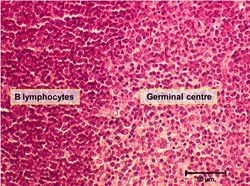Difference between revisions of "B cells"
| Line 1: | Line 1: | ||
| + | {{OpenPagesTop}} | ||
| + | |||
[[Image:LH B cells Peyers Patch Histology.jpg|right|thumb|250px|<p>'''B Cells in Lymph node'''</p><sup>©RVC 2008</sup>]] | [[Image:LH B cells Peyers Patch Histology.jpg|right|thumb|250px|<p>'''B Cells in Lymph node'''</p><sup>©RVC 2008</sup>]] | ||
| Line 13: | Line 15: | ||
<br><br> | <br><br> | ||
{{Jim Bee 2007}} | {{Jim Bee 2007}} | ||
| + | |||
| + | {{OpenPages}} | ||
[[Category:Lymphocytes|B]] | [[Category:Lymphocytes|B]] | ||
Latest revision as of 16:58, 2 July 2012
Also known as B lymphocytes
So named as they were initially found in the Bursa of Fabricius, B cells produce antibodies and are associated with humoral immunity (T cells are part of the cell-mediated immune response), and are an integral part of the adaptive immune system. They represent 20-30% of circulating lymphocytes.
B cells have cell surface proteins known as B cell receptors (BCRs) that are known as immunoglobulins; IgM is the membrane bound BCR that is expressed when the B cell is immature, changing to IgD when the cell is mature. IgM has a large molecular mass and can bind up to 10 antigens simultaneously. B cells also express MHC II, CD9, CD,19, CD20 and CD24.
Under antigenic stimulation B cells differentiate into plasma cells and memory cells.
B-cells also act as Antigen-Presenting Cells (APCs) by presenting digested fragments to T cells on MHC II.
| Originally funded by the RVC Jim Bee Award 2007 |
Error in widget FBRecommend: unable to write file /var/www/wikivet.net/extensions/Widgets/compiled_templates/wrt673e3790431ce5_73681271 Error in widget google+: unable to write file /var/www/wikivet.net/extensions/Widgets/compiled_templates/wrt673e37904af381_08564422 Error in widget TwitterTweet: unable to write file /var/www/wikivet.net/extensions/Widgets/compiled_templates/wrt673e3790529544_60282757
|
| WikiVet® Introduction - Help WikiVet - Report a Problem |
